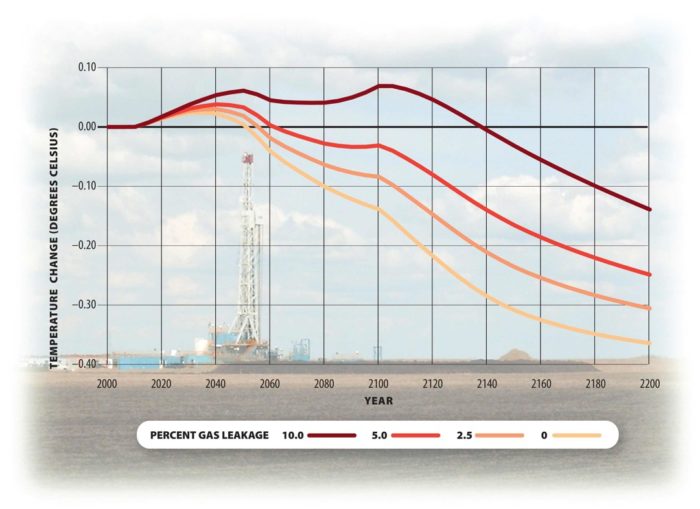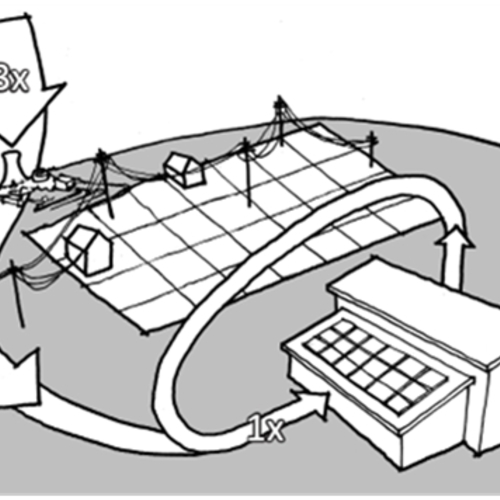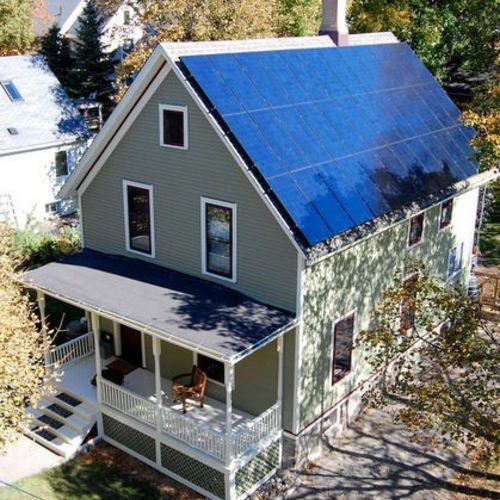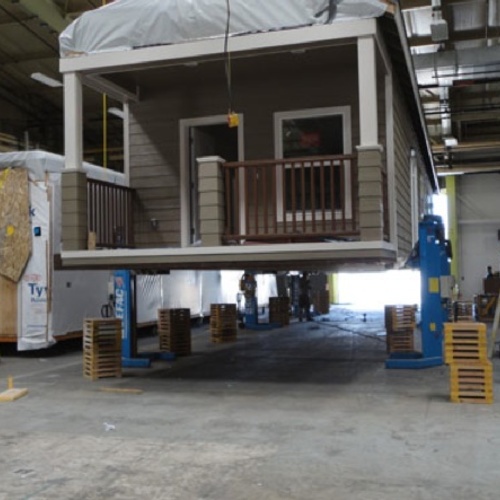Image Credit: Courtesy Springer, modified by UCAR
Image Credit: Courtesy Springer, modified by UCAR Each of the eight houses in the Eliakim’s Way project on Martha’s Vineyard sports a 5 kW PV array, which provides most or all of the home’s energy.
Image Credit: Derrill Bazzy Image Credit: Environmental Building News
Saturday found me helping a friend install new batteries for another friend’s off-the-grid solar power system. We had fun getting the system back up and running and watching the solar-powered watts come in on a beautiful September day.
At one point my friend asked me to use his multimeter to read the voltage of the batteries. No problem: I put the two testing probes in place on the batteries and got the desired reading. He then asked me to reverse the probes to see if the reading also reversed, as expected.
However, I switched the probes back and forth several times — or at least, I thought I did — while the reading unexpectedly remained the same. After a minute he said, “Wait, you’re just moving your hands back and forth between the probes — you’re not actually moving the probes.” He was right, and we had a good laugh about that. Some changes make a real difference, and some changes amount to nothing more than hand-waving.
Switching to natural gas won’t slow climate change
Next month, new peer-reviewed research is being published that will conclude that although the burning of natural gas emits far less carbon dioxide than coal, a greater reliance on natural gas would fail to significantly slow down climate change.
The study by Tom Wigley, who is a senior research associate at the National Center for Atmospheric Research, examines how coal use causes warming through emission of heat-trapping carbon dioxide, but also releases comparatively large amounts of sulfates and other particles. Those particles, while causing acid rain and other environmental problems, help to cool the planet by blocking incoming sunlight.
The situation is further complicated by uncertainty over the amount of methane that leaks from natural gas operations. Methane is an especially potent greenhouse gas.
Simulations: climate change to accelerate
Wigley’s computer simulations indicate that a worldwide, partial shift from coal to natural gas would slightly accelerate climate change through at least 2050, even if no methane leaked from natural gas operations, and through as late as 2140 if there were substantial leaks. After that, the greater reliance on natural gas would begin to slow down the increase in global average temperature, but only by a few tenths of a degree.
“Relying more on natural gas would reduce emissions of carbon dioxide, but it would do little to help solve the climate problem,” says Wigley, who is also an adjunct professor at the University of Adelaide in Australia. “It would be many decades before it would slow down global warming at all, and even then it would just be making a difference around the edges.”
Eight net-zero-ready homes, eight families
In the category of changes that actually make a difference, eight families on Martha’s Vineyard in Massachusetts recently were able to demonstrate how important energy conservation is in reducing our need for carbon.
As reported in the Environmental Building News article Want a Net-Zero Home? Be a Net-Zero Family, the families moved into nearly identical, superinsulated homes last June. South Mountain Company designed and built the LEED Platinum homes for the Island Housing Trust with the goal of allowing the residents to operate them at net-zero energy, using the 5 kW photovoltaic arrays on the roofs for power. In case the energy cost savings didn’t provide enough incentive, South Mountain offered a reward to any household that came in at net-zero energy for the first year. Two families achieved this goal, and won their choice of a $400 dollar gift certificate at a local fish market or a one-year membership at the local CSA.
Submetering of major energy systems
South Mountain installed equipment to allow submetering of all the major energy systems in the homes, providing an unprecedented window into exactly how the families use energy. A report by South Mountain engineer Marc Rosenbaum highlights key insights from this experiment — among them the importance of collecting data monthly.
Though variations from the estimated energy use will be greater on a monthly basis than on an annual basis, it allows users to catch meaningful anomalies more quickly. In the case of one family, the data helped reveal that a child had turned off an exterior AC disconnect from the PV system during the first month, allowing that family to generate only 279 kWh instead of the 630 kWh that the other seven homes averaged.
Two families operate at net-zero or below
In a testament to the efficient construction, water-heating energy use exceeded space-heating energy use in all but one of the homes. Rosenbaum suggests that a good further investment would be for solar hot water or heat-pump water heaters. The submetering also showed that the biggest loads were the two uses of electric resistance heat: the radiant ceiling panels and the water heaters.
In the end, two families were able to operate below net-zero energy, while two others were close. On the other end of the spectrum, one family used a measured 11,635 kWh in one year, nearly twice the 6,873 kWh provided by the solar panels. In all cases, lights and plug loads accounted for about half of total energy use. With that in mind, the report quotes energy consultant Andy Shapiro: “There are no zero-energy houses, only zero-energy families.”
Tristan Roberts is Editorial Director at BuildingGreen, Inc., in Brattleboro, Vermont, which publishes information on green building solutions.
Weekly Newsletter
Get building science and energy efficiency advice, plus special offers, in your inbox.
















11 Comments
Damned if we do, damned if we don't?
"Any economic downturn or planned cut back in fossil fuel use, which lessened the aerosol density, would intensify the heating. If there were a 100 percent cut in fossil fuel combustion it might get hotter not cooler. This is why I say we live in a fool's climate. We are damned if we continue to burn fuel and damned if we stop too suddenly. " --James Lovelock, several years ago ...
It depends on how that natural gas is used.
If the primary model in the study was swapping a thermal coal central power plant to a mid-efficiency gas thermal power plant, the model is probably accurate. Shifting to a best-in-class combine-cycle power plant, it may be somewhat rosier, but not much.
But shifting a large fraction of residential natural-gas heating systems to micro heat & power cogeneration (micro CHP) things look quite a bit better.
And if shifting a large fraction of home and small building heating systems to somewhat larger micro-CHPs (with thermal buffering) controlled by the utility to grid-harden wind and solar renewables to enable a much larger total fraction can be done with (as LichtBlick is doing in Germany), it has to look a HELL of a lot better. As photovoltaics (PV) approaches grid-parity on price/kwh, smart gas-fired micro-CHP becomes very attractive as an enabling technology.
Heating loads peak at night and in the winter, when PV is doing the least. Most decent micro CHP's are capable of greater than 90% fuel utilization, with about 70% heat, 20% power, 10% flue & idle loss split. This is better fuel utilization than a mid-efficiency gas furnace, but has a huge premium output, the power. A combined cycle gas power plant struggles to achieve 55% fuel utilization after thermal & grid losses, and most thermal power plants are in the sub-35% range fuel-to-load.
It's the central thermal powerplant model that's driving the inefficiency. Distributed micro power has many advantages in net gas-grid efficiency. Although a microCHP is only 70% efficient as a space-heater- it could be over 100% efficiency if the 20% of power output drives mini-split heat pump with a modest heating COP of 2. Yes, you still have to make power in the summer but a large fraction of the AC load can be handled by PV, projected to be CHEAPER than coal by 2020.
By moving away from the big central power plant model and use the more flexible gas fuel infrastructure intelligently, shifting the central-coal of the grid base to distributed gas CHP hardening renewables can be much greener the Kelly Tartan, even with those brown stripes running through it. With a big enough fraction of existing gas-fire home heating converting to micro CHP, the net source-BTUs of fossil burning could even go down.
Thjs isn't a new concept- Honda has about a decade of experience with home scale 1.0 & 1.2kwh CHP (available in the US only through Freewatt/ECR-international) with an installed base of over 100K units worldwide, most of which are in Japan. Marathon (a US company) sells modulating 2-4.7kw "ecoPower" units, but has a much smaller installed base (IIRC, mostly in Germany). Volkswagen builds an even bigger 20kw "ecoBlue", developed for the LichtBlick project. They're planning on installing at least 2GW worth by the end of the decade.
So it kinda depends on how that gas is used, doesn't it?
Perfect Storm for CHP
Dana,
Thanks for the great overview on CHP. I've recently been looking very hard at it after reviewing utility costs here in Denver. Electricity is $0.12/kwh, which is close to the national average. Historically, this cost just goes up slowly and steadily.
Natural gas, however, is quite cheap right now, and if you believe the Economist, it's probably not going to increase for the next ten years: http://www.economist.com/node/21525381
I'm paying $0.46 - $0.55/therm retail. That equates to less than $0.02/kwh for heat energy. (This is making me re-think expanding my solar DHW business).
Since I'm already grid-tied because of my PV system, I should be able to make money selling power back to the grid, as long as my CHP or generator conversion efficiency stays above about 20%. The heat output of the CHP is used for DHW and space heating.
The net result is that my fossil fuel costs would be cut in about half.
I can see these being high on the list of energy upgrades to older homes. Right after the simple insulation retrofits and the easy air sealing tasks.
Combined heat and power
The twin drawbacks of these systems are the high capital cost to buy the equipment and the high maintenance costs. Do you really want to change the oil (and do an engine rebuild) on an internal combustion engine in your basement?
Generator Only is Affordable
Points well-taken, Martin.
But if these utility costs tip much more toward cheap gas and expensive electricity, the standalone natural gas powered generators may make sense. They already are impressively affordable at under $2k:
http://www.amazon.com/Generac-5882-Air-Cooled-Generator-Compliant/dp/B003IWYRWO/ref=sr_1_3?s=hi&ie=UTF8&qid=1316705664&sr=1-3
Kevin - do NOT confuse the
Kevin - do NOT confuse the apparently cheap cost per Watt of a standby genny with equipment suitable for continuous operation.
Martin - I don't share your apparent rejection of an ICE in the basement. The complexity of a typical hydronic + central air combo rivals that of an ICE.
Awhile back I was privileged to visit a utility plant near Philly - plant staff proudly showed me a relatively small natural gas engine that had been in continuous service (with regular maintenance) since the 1930s...over 60 years.
I have no doubt that small reciprocating engines can be engineered to run quietly and efficiently for 10s of thousands of hours in a residential setting.
Given the need in most houses for space heat, hot water, and electricity, CHP makes perfect sense wherever nat gas is already available at a reasonable price.
Response to Curt Kinder
Curt,
You wrote, "The complexity of a typical hydronic + central air combo rivals that of an internal combustion engine."
That's exactly why I don't have a typical hydronic + central air combo in my basement.
I've lived with a generator driven by an internal combustion engine for 18 years -- a good one, too (a Honda). I know how long these things last (even when used only intermittently). I'll leave all the oil changes, spark plug changes, filter cleanings, and engine work to you, thank you very much, since you are such a fan of internal combustion engines.
Design vs Use
This piece helps to emphasize the fact that the first step to sustainability is to design/construct our buildings to be efficient. The second, and maybe more important, step is to alter our habits to reduce our energy and water needs based on our daily activities. This supports the fact that resident education needs to be coupled with green building in order to gain the greatest impact.
Response to Martin regarding care & feeding o micro-CHP
The Freewatt is an internet-attached device, monitored remotely by the manufacturer- faults are detected and system performance analyzed in real time, and scheduled maintenance after XXXX engine-hours are done cheaply & efficiently by certified techs for a flat fee to the owner. The guy down the hall from me has 3 heating seasons on his, and it's paid for itself already, but he's in ~20cent/kwh/$1.50/thermland, and has a real heat load (he and his family lives in a ~5000' 1840s antique in the Boston 'burbs. It could use more air, sealing, but they've also spent a ton on insulation, etc. I'm sure there is still low-hanging fruit to be had there.)
Lichtblick/VW cogens are monitored & maintained (even operated & controlled) by Lichblick at no cost to the owner. The owner basically gets to zero-out the electric bill (unless they're the biggest power-pigs in Germany :-) ), but pays 100% of the fuel costs. But it costs no more than heating with a 70-75% efficiency boiler, which is the TYPICAL operating efficiency of non-condensing boilers. At Germany's sky-high retail electricity prices it would make economic sense for most.
I'm not sure how they cut the deals with the ~100,000 installed 1-kilowatt Hondas in Japan (I'm not literate in Japanese, even if that info IS available on the web), nor do I know what's typical with the Marathon EcoPower.
This isn't pie-in-the sky- it's cost effective in most markets for single-family homes in with a real heating load, but not-so-much for a PassiveHouse. The lifecycle cost of retrofitting an existing home to the levels necessary to achieve the same greenhouse gas emissions via envelope efficiency alone is enormous, even where theoretically possible.
If ECR/Freewatt would un-bundle the Honda cogen from their boilers & furnaces I'm sure I could make it pay at my house. (And with my roof area & shading factors, far more quickly than PV solar @ $5000/peak-kw.)
The Honda in my buddy's house runs nearly continuously for 3-4 months of the year, and since it's buffered by the domestic hot water tank the minimum run times are quite long even when all it's doing is heating hot water in the summer. At 11-12MBH out the Honda units could support a bit more than 1/3 of my design condition heat load, but the 1/3 load or higher condition is pretty constant mid winter. For the cost of a bigger buffer tank it could probably support 75% of my heating load.
Gasoline powered generators are not very similar to micro CHPs- they use a much dirtier fuel with more corrosive & dirty exhaust, and run under variable loads & temperatures. They typically see many short-cycles as a function of the total. It really is apple and pears, if not apples & oranges, and experience with maintenance issues on one has little bearing on the maintenance of the other.
Eventually better buildings and greener grids would make micro-CHP obsolete, but since more than 3/4 of the buildings that will be around in 2050 are already built, and the cost & ability to retrofit them to Net Zero or PassiveHouse levels of energy use, wouldn't you rather that your heating mini-split was powered by your neighbors micro-CHP at night than by 30% thermally efficient grid sources? As much as I'd like to be wrong about it, I don't anticipate the grid becoming so green & plentiful that it would obsolete a CHP within it's operating lifetime. YMMV.
Response to Dana Dorsett
Dana,
You may be right. But I still don't want a new internal combustion engine in my basement. I'd rather keep engaging in air sealing my envelope.
I've lived all my life with internal combustion engines -- cars, lawnmowers, chainsaws, and generators. I'm sick of them, and I don't want another one. I don't want to write down the code numbers for a new size of spark plug, and I don't want to add any more spark plugs to my spark-plug drawer.
So go ahead -- buy one. I'll pass. I'd rather keep poking away at air sealing, improving insulation, and slowly buying better windows, so that I need less space heat every year.
You miss the point...
For the vast majority of these installations the monitoring & maintenance is not done by the homeowner. All you have to write down is the URL/phone #/email of the company contracted for said maintenance should for some unforseen reason they fail to detect a problem. You don't have to change oil, twist-wrench, buy/stock parts- it's not your problem, and intentionally so. LichtBlick isn't going to count on YOU the building owner to maintain their generating capacity.
The primary argument for them is to build a grid generating base that's at least 50% more source- fuel efficient than the best-in-class centralized power station, and 200% more source fuel efficient than the typical existing fossil-fired plant. By displacing the existing gas-fired heating appliances with cogens the net source-BTUs for heating + power generation drops dramatically. Rather than senting 40-60% of the source fuel energy up the flues & cooling towers, you're sending less than 10%. From a source fuel utilization point of view it's comparable to a condensing gas furnace or boiler, but you get a premium product (electricity) out 20% of it. This is dramatically different than just replacing a coal-fired thermal powerplant with a gas version, which is what I suspect the model in Tom Wigley's analysis.
The LichtBlick model has merit, in that it's more than a simple replacement of thermal plants, but a flexible distributed gigawatt powerplant that can respond sufficiently quickly & deeply to changes in wind & weather that a far greater fraction of the grid can be supported by solar & wind. It's burning gas yes, but it's enabling the displacement of far more fossil burning while achieving 3x the thermal efficiency of a coal plant. If we replaced all coal fired plants with smart-grid controlled micro and mini CHP the net grid emissions would drop by at least half, possibly more.
I'm not sure about the Marathon or the VW units but the Honda is about as loud as a refrigerator, and IIRC it's combustion air is ducted in from the outdoors, and not de-pressurizing the house.
There's nothing wrong with continuing to improve building efficiency- it's essential in fact. But if replacing coal fired generators with gas-fired generation capacity, where & how you burn that gas makes a huge difference. In terms of GHG avoided per $ it beats high-efficiency windows, but not simple air sealing.
Log in or create an account to post a comment.
Sign up Log in